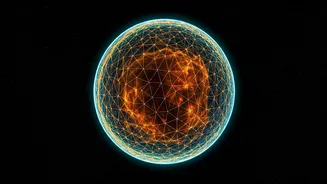A Cosmic Panorama
The endeavor involved an advanced radio telescope known as the Murchison Widefield Array (MWA). Scientists utilized this instrument to gather data. The outcome
is the most comprehensive radio map ever made of the early universe. The map captures an era over 13 billion years ago, giving a window into the initial stages of cosmic development. The level of detail allows for observing the period when the first stars and galaxies lit up the universe. This provides a clear picture of how those structures started forming. This radio map is significant because it allows researchers to study the cosmic dark ages. Those dark ages were a time when neutral hydrogen filled the cosmos. Researchers can now decode clues about the reionization epoch. That's when the first stars and galaxies emitted radiation that transformed the universe. This detailed map is important for grasping the complex processes that shaped the universe.
Decoding Early Signals
The MWA's design allows it to identify faint radio signals from space. Its location in Western Australia's remote outback helps minimize radio interference. The team carefully processed data over several years. This resulted in a clearer image of cosmic events. The radio map focuses on the 80 to 300 megahertz frequency range. This range includes emissions from the early universe. Analyzing these frequencies reveals information on how energy spread through space. It also provides insights into the evolution of primordial gases. This project provides a new level of detail for astronomers. They can now investigate the fluctuations in the early universe, which are crucial for our understanding. This is crucial as these fluctuations contributed to the structure of galaxies and galaxy clusters.
Unveiling Cosmic History
The creation of this radio map required advanced data processing techniques. The MWA gathered thousands of individual observations. These were carefully combined to create a unified view. This was a complex task due to Earth's atmospheric effects. Those effects distort the radio signals. Scientists created algorithms to correct these distortions and enhance the map's clarity. The outcome is a detailed representation of the early universe. This offers fresh insights into the cosmic history. The research team's findings challenge previous models. It opens avenues to rethink our ideas of the universe's initial conditions. This data is expected to clarify the nature of dark matter and dark energy, the fundamental components of the universe. The project's success motivates further study. Researchers are building more sensitive telescopes.
Future Discoveries Ahead
The radio map generated by MWA is more than just an image. It is also an effective tool for future research. Scientists are using it to refine simulations of cosmic evolution. They hope to understand how the first stars and galaxies formed. The map will help in the search for the signal from the epoch of reionization. This is the period when the universe's first light started to shine. This new data will allow scientists to analyze the impact of different energy sources on the early universe. Researchers aim to detect signals of cosmic events. Those signals may reveal characteristics of the first black holes. The success of this project encourages ongoing exploration. It could lead to a deeper understanding of the universe's formation and its current state. Scientists anticipate that these discoveries will reshape our view of cosmic history.
















